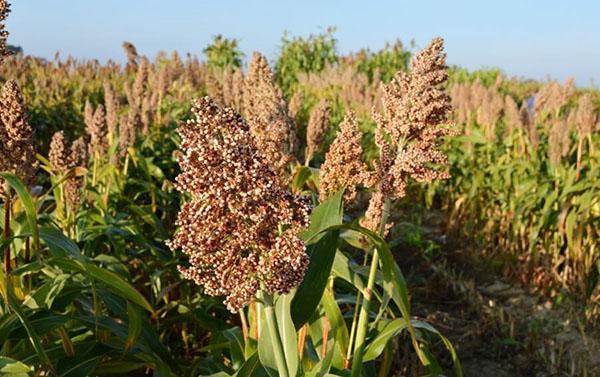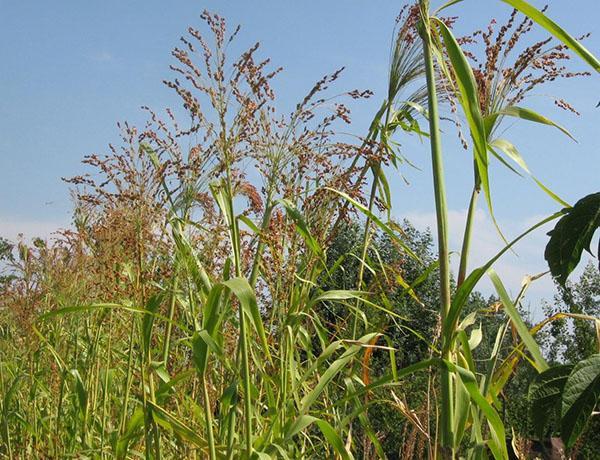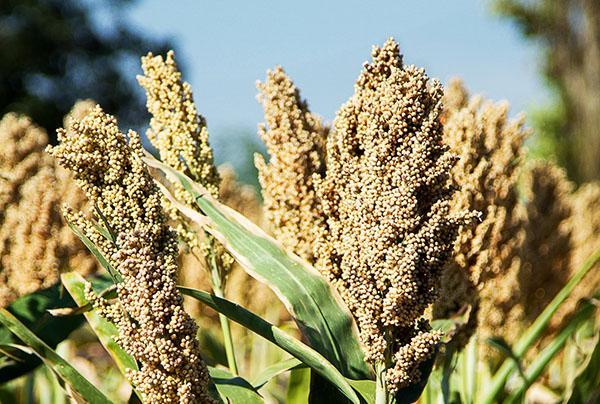What is interesting about agrotechnics of sorghum broom
 Sorghum is a spring, thermophilic crop with a wide range of applications. Agrotechnics of broom sorghum is practiced in the southern regions of Russia, Ukraine and other countries, in conditions of moisture deficit, an arid climate, and at a sufficiently high air temperature. Culture occupies a significant place in the structure of the feed ration of farm animals. Sorghum is used as feed for pigs, cattle, other ungulates and birds. A concentrated feed made from sorghum grain, fed to pond fish.
Sorghum is a spring, thermophilic crop with a wide range of applications. Agrotechnics of broom sorghum is practiced in the southern regions of Russia, Ukraine and other countries, in conditions of moisture deficit, an arid climate, and at a sufficiently high air temperature. Culture occupies a significant place in the structure of the feed ration of farm animals. Sorghum is used as feed for pigs, cattle, other ungulates and birds. A concentrated feed made from sorghum grain, fed to pond fish.
Characteristics of culture

The leaves and stem are covered with a waxy coating, the grain contains tannin alkaloids, which provides resistance to pests and diseases. The nutritional value of grain, sorghum for silage and green mass does not lag behind maize (starch - 72-75%, protein - 13-15%, fat - 4.0 - 4.5%), contain a wide range of vitamins and microelements.
 Various types of sorghum are cultivated: ordinary, sugar, tailed, grain. The choice directly depends on the nature of use. Sorghum for feed is grown mainly of sugar varieties. One of the species - broom or panicle sorghum (S.technicum) is grown for the manufacture of strong, light, elastic brooms.
Various types of sorghum are cultivated: ordinary, sugar, tailed, grain. The choice directly depends on the nature of use. Sorghum for feed is grown mainly of sugar varieties. One of the species - broom or panicle sorghum (S.technicum) is grown for the manufacture of strong, light, elastic brooms.
To obtain high-quality material of technical type sorghum in difficult climatic conditions, certain agrotechnical rules must be strictly observed.
Agrotechnics of sorghum broom for obtaining a high-quality harvest
 If desired, summer residents can grow broom sorghum in their area. You just need to follow all the recommendations of specialists for growing a plant.
If desired, summer residents can grow broom sorghum in their area. You just need to follow all the recommendations of specialists for growing a plant.
Seed preparation
It is better to buy seeds in specialized stores, where they are sold completely ready for planting. If the quality of the seeds is in doubt, you can check them yourself:
- Soak them for half an hour in a deep container. Seeds that float to the surface are discarded.
- In dry, windy weather, winnow the grains. Light, low-quality seeds are blown far away, and suitable for sowing will fall nearby.
Sorghum seeds rejected for sowing are used as pig feed and other animals.
In order to avoid the disease of young seedlings with Fusarium under unfavorable weather conditions, the seeds are dressed (for example, Maxim XL 035 P5, in accordance with the manufacturer's instructions).
The soaked seeds are dried before sowing.
Site selection and preparation
 Sorghum is an undemanding crop, in one area it can yield up to 7 years. The main thing is that it is well fertilized. It is grown on various types of soils: saline, sandy, loamy soils. The culture does not bear fruit well on excessively moist and acidic soils. When growing sorghum for silage, you should not choose overdried areas, since the lack of moisture will not ensure the output of green mass. Legumes, row crops and winter cereals are suitable as predecessors.
Sorghum is an undemanding crop, in one area it can yield up to 7 years. The main thing is that it is well fertilized. It is grown on various types of soils: saline, sandy, loamy soils. The culture does not bear fruit well on excessively moist and acidic soils. When growing sorghum for silage, you should not choose overdried areas, since the lack of moisture will not ensure the output of green mass. Legumes, row crops and winter cereals are suitable as predecessors.
The main thing in agrotechnics of broom sorghum is proper soil preparation, which includes:
- Deep autumn plowing (25-27 cm). Depending on the state of contamination of the field after the predecessor, stubble cultivation can be carried out first.
- Application per 1 m2 for autumn plowing of organic fertilizers (200-250 kg of rotted manure) and mineral (4-5 kg superphosphate, 2-3 kg of potash) fertilizers.
- In early spring - harrowing of the soil followed by cultivation.
- Continuous soil tillage with continuous herbicides (glyphosate).
To improve seed germination, pre-sowing and post-sowing soil rolling is carried out.
Sowing
 The sowing scheme depends on the variety and the purpose of the crop:
The sowing scheme depends on the variety and the purpose of the crop:
Sorghum for feed in the form of concentrated feed - 70x70 cm, 70x90 cm, 90x90 cm.
Sorghum for silage - using an ordinary solid method or two lines each -40x60x15 cm.
For agrotechnics of broom sorghum - in a wide-row method with row spacing up to 70 cm.
Sowing is carried out when steadily warm weather sets in, when the threat of frost has passed and the soil warms up to 10 -15 oC. The optimum seeding depth is 5-6 cm.
Crop care
 At optimum temperature and humidity, plants will sprout within a week. The most effective agricultural technique is soil loosening, which helps to retain moisture and improves air flow to the roots. In the first month after germination, shoots grow and develop very slowly, therefore, it is necessary to regularly destroy fast-growing weeds that inhibit young shoots. With a weak weediness of the fields, mechanical weeding is enough, which is carried out in the aisles when loosening the soil several times per season. On heavily contaminated areas, chemical protection agents are used.
At optimum temperature and humidity, plants will sprout within a week. The most effective agricultural technique is soil loosening, which helps to retain moisture and improves air flow to the roots. In the first month after germination, shoots grow and develop very slowly, therefore, it is necessary to regularly destroy fast-growing weeds that inhibit young shoots. With a weak weediness of the fields, mechanical weeding is enough, which is carried out in the aisles when loosening the soil several times per season. On heavily contaminated areas, chemical protection agents are used.
Cleaning

Harvesting times differ significantly:
- Sorghum for forage in the form of green mass is harvested from mid-July to late August in the phase of going into the tube.
- Cereal varieties are harvested at full maturity.
- Sorghum for silage is mowed at the stage of wax ripeness of seeds.
- With the agrotechnology of broom sorghum, the panicles are harvested, and then the rest of the stem is mowed. The optimal length of the panicle is 40 - 50 cm, the legs are 35 - 40 cm. Cleaning is not delayed, it is carried out at the end of the milk phase so that the green mass does not harden. Brooms for the production of brooms ripen naturally.
Broom sorghum is a crop that deserves attention and gives a good economic effect in the production for technical purposes and the expansion of the forage base in arid regions.